Stock prices rose this week, with particularly good news on Thursday and Friday from the energy market. Crude oil futures fell below $58 per barrel on Thursday and Friday, helping to alleviate fears of inflationary pressures. Moreover, lower energy prices also suggest that consumers and businesses may be more likely to spend money in upcoming months. As of Friday, the Dow Jones Industrials was the only major index below year end (2004) levels with a drop of 0.9 percent. The Nasdaq composite index is up 1.2 percent from year end; the S&P 500 is up 1.9 percent from year end, the Russell 2000 is up 2.3 percent, and the Wilshire 5000 is up 3.3 percent. None of these are stellar performances, but an increase beats a decrease any time!
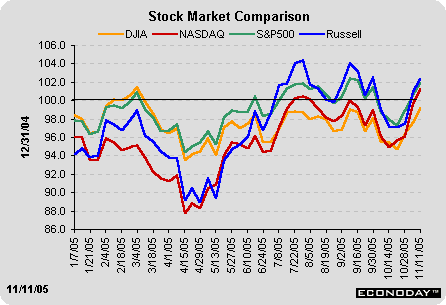
BONDS
Treasury yields fluctuated this week, but ended the week lower, primarily after seeing crude oil prices dip below $58 per barrel on Thursday. The bond market was closed on Friday, celebrating Veterans' Day. Crude oil prices declined on Thursday on news from the International Energy Agency that oil demand is down and supply risks are reduced from the past couple of months. Treasury market players also faced the quarterly refunding this past week with generally good results on the 3-Year, 5-Year and 10-Year note auctions.
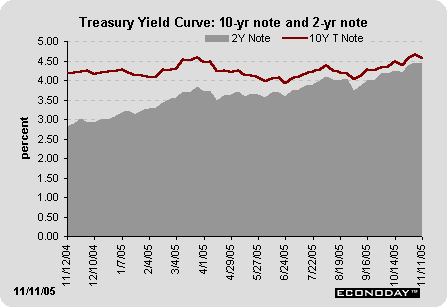
Markets at a Glance
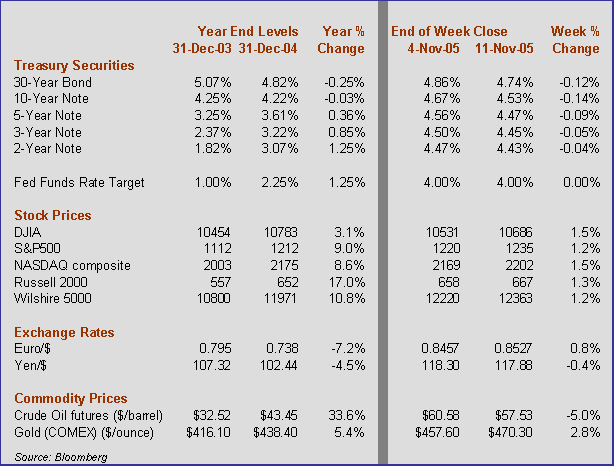
Weekly percent change column reflects percent changes for all components except interest rates. Interest rate changes are reflected in simple differences.
The Economy
LINGERING KATRINA IMPACTS - THE TRADE DEFICIT
The international trade deficit on goods and services surged in September to reveal a $66.1 billion shortfall as exports fell 2.6 percent and imports rose 2.4 percent. A good chunk of the drop in imports was due to trouble at the port of New Orleans, as well as the ports of Houston, Mobile, Alabama and Gulfport, Mississippi. In addition to the hurricane problems, aircraft shipments also dropped - probably reflecting the mechanics' strike at Boeing. On the import side, oil prices jumped 8 percent - clearly increasing total import values, although total petroleum product imports didn't increase during the month because goods could not get through the Gulf.
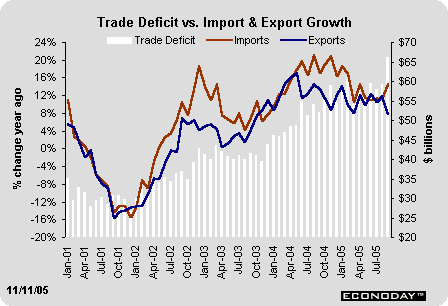
The Bureau of Economic Analysis estimated that the September trade deficit would indeed deteriorate from the August pace, but they did not expect the large spurt for the month. Consequently, they will be revising down their estimates for exports and increasing their estimates for imports. That translates into a larger net export balance and a drag on third quarter GDP growth. Until the trade deficit was released, some economists were revising up their forecasts for the first revision of third quarter GDP, but now they will have to revise these forecasts down again. Real GDP growth is likely to end up somewhat lower than the 3.8 percent rate of last month's advance estimate.
PRICE BREAK
Import prices fell 0.3 percent in October after increasing 2.3 percent in September. The October drop was spurred by a 4.4 percent decline in petroleum import prices. These had posted average monthly gains of 7.7 percent in each of the three previous months! Thus, the October decline is just a drop in the bucket. Petroleum import prices are roughly 31 percent higher in October versus a year earlier. This brings total import prices 8.1 percent over year-ago prices, but nonpetroleum import prices are only 3.7 percent higher than a year ago.
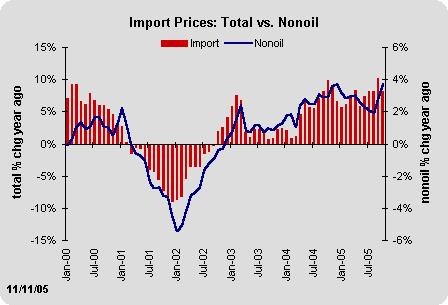
The energy component of the producer price index for finished goods generally moves in line with the price index for petroleum import prices. This means that the energy price component of the PPI for October will likely show a price drop for the month.
By the way, the International Energy Agency believes the global oil market is recovering from the U.S. hurricane season. They don't believe supply risks have disappeared, just dissipated. Also, while prices have come back down to levels of the pre-hurricane season, these levels are still high. Funny how $60 per barrel oil appears cheap these days, doesn't it.
CONSUMERS MAKE THE MONEY-WORLD GO ROUND AND ROUND. . .
Consumer installment credit dipped $0.1 billion in September after expanding $8 billion in August. Revolving credit grew $4.7 billion - suggesting that people are still spending on their credit cards. However, nonrevolving credit declined $2.8 billion in September, reflecting the drop in motor vehicle sales. The chart below shows that consumer credit has moderated in the past few months. Incidentally, if you plot consumer credit against motor vehicle sales, you will find, most of the time, that the big spikes in consumer credit are due to spikes in motor vehicle sales. If motor vehicle sales fall off, consumer credit will continue to moderate in coming months.
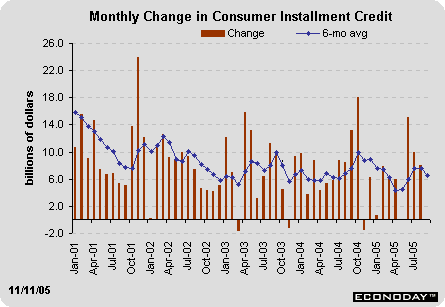
Consumers may be feeling a little bit better these days than they were in September and October. The University of Michigan's consumer sentiment index inched up to 79.9 in mid-November from October's level of 75.4. Consumers are feeling better about current conditions as well as their expectations of the upcoming six months. However, make no mistake - no one would call consumers optimistic. No doubt, consumers are relieved that gasoline prices have come back down from super high levels of the past couple of months. Keep in mind, however, that while gas prices are lower than post-Katrina, they are still fairly high and back to pre-Katrina levels. That's not much better. A few words of caution - the uptick in November sentiment doesn't automatically point to an uptick in retail sales. It remains to be seen whether holiday sales will be above - or below normal.
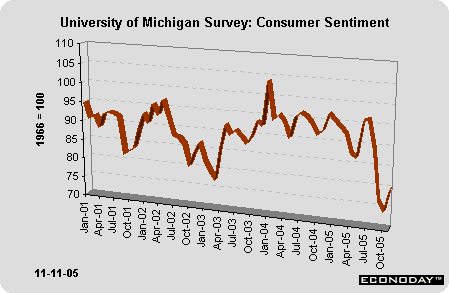
The Bottom Line
The international trade deficit was larger than economists predicted - and larger than expected by the Bureau of Economic Analysis. This means that the revised estimate for the third quarter will show a larger net export deficit and a larger drag on GDP growth.
Energy prices declined in October - and the import price index is usually a good lead indicator for the PPI. But what about the core' Both the PPI and the CPI will be reported next week and are bound to get a lot of attention.
Ben Bernanke, nominated to replace Alan Greenspan as Fed chairman, is also on the docket next week as his confirmation hearings begin at the Senate Banking Committee.
Looking Ahead: Week of November 14 to November 18
Tuesday
The producer price index jumped 1.9 percent in September, spurred by a 7.1 percent hike in energy prices. Excluding energy and food, the PPI rose 0.3 during the month. Petroleum import prices fell in October and this bodes well for the energy component of the PPI since the two often move in tandem.
PPI Consensus Forecast for Oct 05: 0.1 percent
Range: -0.5 to 0.4 percent
PPI ex food & energy Consensus Forecast for Sept 05: 0.3 percent
Range: 0.1 to 0.3 percent
Retail sales inched up 0.2 percent in September, dampened by a 2.8 percent drop in motor vehicle sales. Excluding autos, sales jumped 1.1 percent, although largely due to higher gasoline prices. Motor vehicle sales plunged during the month and this will push down total sales. Nonauto retail sales may appear dampened in October if gasoline station sales decline because of gas prices, so be cautious in interpreting these data when the headline numbers are reported.
Retail sales Consensus Forecast for Oct 05: -0.6 percent
Range: -0.4 to -1.0 percent
Retail sales ex autos Consensus Forecast for Oct 05: 0.3 percent
Range: 0.1 to 0.4 percent
The Empire State manufacturing index fell back to 12.1 in October after declining from a summer high of 23.9 in July. Despite last month's moderation, it still pointed to solid growth in manufacturing activity in this Fed region.
Empire State index Consensus Forecast for Nov 05: 17
Range: 15 to 20
Wednesday
The consumer price index jumped 1.2 percent in September after posting hefty gains in the two previous months - due primarily to energy price spurts. Excluding food and energy, the CPI rose 0.1 percent for the month. Energy prices will likely dip in October.
CPI Consensus Forecast for Oct 05: 0.1 percent
Range: 0.0 to 0.1 percent
CPI ex food & energy Consensus Forecast for Oct 05: 0.2 percent
Range: 0.2 to 0.3 percent
Business inventories rose 0.4 percent in August and another rise is expected in September. Manufacturers' inventories dipped 0.1 percent after decreasing 0.2 percent in the previous month, while wholesale trade inventories rose 0.6 percent; only retail trade inventories are missing.
Business inventories Consensus Forecast for Sept 05: 0.3 percent
Range: 0.2 to 0.6 percent
Thursday
New jobless claims rose 2,000 in the week ended November 5 to 326,000. Fewer and fewer claims are related to hurricanes Katrina and Rita each week, although a few in the week were related to Wilma. While new claims are not accelerating anymore, continuing claims remain at very high levels: it will take more than a few weeks for hurricane victims to find new jobs.
Jobless Claims Consensus Forecast for 11/5/05: 325,000 (-1,000)
Range: 315,000 to 325,000
Housing starts increased in September to a 2.108 million unit rate with increases in both single-family and multi-family construction. Economists are not expecting an acceleration in October. The positive impact of rebuilding after Katrina and Rita is not likely to show up for several months.
Housing starts Consensus Forecast for Oct 05: 2.05 million-unit rate
Range: 2.00 to 2.12 million-unit rate
The index of industrial production dropped 1.5 percent in September, held down by hurricanes Katrina and Rita as well as a mechanics' strike at Boeing. Factory payrolls rose in October and the workweek increased sharply as well. This should boost production for the month.
Industrial production Consensus Forecast for Oct 05: 1.0 percent
Range: 0.5 to 1.5 percent
Capacity utilization rate Consensus Forecast for Oct 05: 79.6 percent
Range: 79.2 to 80.1 percent
The general business conditions component of the Philadelphia Fed's business outlook survey jumped to 17.3 in October from a low level of 2.2 in September. This was in sharp contrast to other manufacturing surveys last month.
Philadelphia Fed survey Consensus Forecast for Nov 05: 15
Range: 9.5 to 20




